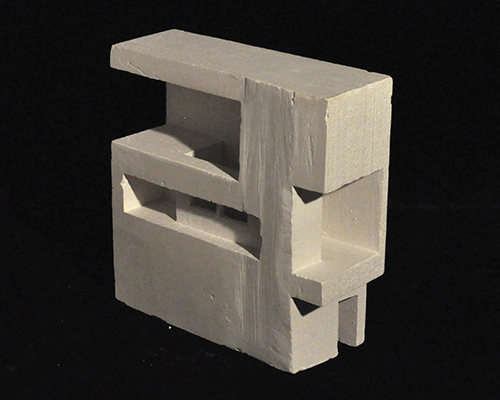| Quentin Andreotti, Anders Stenholm, Arvid Forsberg, Måns Björnskär |
Experimental Explorations on Space and Structure - HS2014
Design Exploration
For the HS2014 the emphasis has been put on the design
operation of carving and the solid-void duality. The course also offered short
tutorials to equip the students with basic skills for the elaboration of physical and digital models. Following the theoretical and
practical inputs, the students,
organized in groups, have been asked to develop a design exploration at the building scale.The design exploration has been undertaken
by the students following four main steps, working at the same time with digital and
physical models.
In Step 1 (Spatial Articulation), the students picked four programmes (2 public and 2 private) and produced four spatial voids, which
represent the spaces were the activities take place. After dimensioning the spatial voids according to proportion criteria, the
students developed a concept to articulate them in space, following specific connection logics (internal circulation, visual
interdependency, activities interaction). Then, they generated a solid mass that contains the spatial voids in the form of a bounding
box and using Boolean operations, they subtracted the spatial voids (positive) from the solid mass in order to produce a hollowed
solid (negative), and as such a stereotomic model (positive+negative).
In Step 2 (Static Stability), the students tested the structural behaviour of their hollowed solid. After defining the position of 3
supports and locating the centre of mass of the system, the students tested the consequences of removing mass from their hollowed
solid or modifying the position of the supports on the overall static stability of the system under self-weight.
In Step 3 (Adaptation to Context), given a specific site in the old city centre of Zürich, the students worked with the operations
introduced in the previous steps to fully develop their design exploration. They were allowed to remove mass from the hollowed solid
in order to incorporate inputs such as access, circulation and views according to the given urban and environmental context.
Moreover, they modified their hollowed solid by removing internal mass in order to incorporate servant spaces like services and
internal circulation.
In Step 4 (Materiality), the students developed a material concept that addresses both the structural expression and the spatial
qualities of their building.
Teaching Team
Juan José Castellón, Pierluigi D′Acunto, Alessandro Tellini, Prof. Dr. Joseph Schwartz
Invited Guest
Miquel Rodriguez (xmade)
Students
Jan Vogler, Yannick Bühler, Kristijan Turnovski, Nathalie Ender, Jann Erhard, Jonas Meylan, Jeremy Ratib, Emma Flores Herrera, Tobias
Gagliardi, Tania Depallens, Anne-Cécile Carfantan, Leo Kleine, Patrick Ohlbrock, Lukasz Pawlicki, Thierry Jöhl, Nathanael Weiss,
Arturo Roth, Meloek Mlihi, Francesca Leibowitz, Aramis Vincenzi, Francesca Zecca, Arnau Pascual Carreras, Andrea Gonzalez Palos,
Houston Burnette, Altair Cerda Tirado, Camilla Gormsen, Xiao Wei Lim, Jean-Marc Stadelmann, Mirjam Minder, Leonie Lieberherr, Emma
Velterop, Yanuo Shi, Ting Cao, Quentin Andreotti, Anders Stenholm, Måns Björnskär, Arvid Forsberg, Matteo Ricchi, Fabio Agustoni,
Emile Corthay, Tristan Wicht, Basile Diem, Filip Grebác, Anouchka Kalznarek
last modified 27.3.2020
